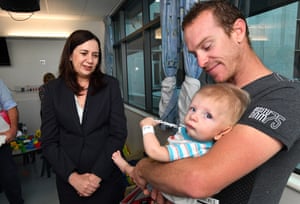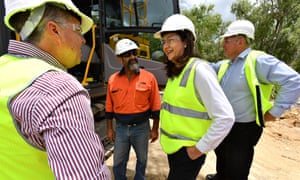It only took a few minutes for the wheels to fall off Labor’s re-election campaign.
Moments after announcing she was sending the state back to the polls, Annastacia Palaszczuk was ambushed by anti-Adani protesters, who hijacked the media event to ask why Labor was still supporting the controversial mining project.
As Queensland police officers walked the protesters off the stage, Palaszczuk attempted to laugh it off.
But they were back again the next day, finding the premier at her next event. And then at the next event.
Coverage of Adani dominated the campaign coverage. Any announcement Palaszczuk attempted to make was done in the shadow of Adani. The campaign went into defence mode from the first moments and it stayed there for the next few days, until the end of the first week, when Labor set off its own bomb.
In a 45-minute press conference, Palaszczuk announced she would veto any decision by the Naif to loan Adani the $1bn it wanted for the rail link, which means if Labor is re-elected and the federal government wants to provide the funds, it will need to find another mechanism which does not need a state tick and flick.
But rather than put an end to the issue, Palaszczuk found herself bogged down by the issue even further.
The protesters may have left, but the questions didn’t.
Any message Labor may have been attempting to send last week was lost in a sea of veto-related questions.
What other projects did Drabsch work on? Would she veto those? Why did she go further than the integrity commissioner recommend, and not just leave the room when cabinet discussed any loan? Did she do it to save inner-city seats? Why wasn’t it done earlier?
Why had Labor tried to walk both sides of the street on the Adani issue? Did she believe she had cost regional Queensland much-needed jobs?
In the mean time, the Liberal National party, led by the Newman government treasurer Tim Nicholls, had taken a leaf from Palaszczuk’s 2015’s campaign against his then-government, and made himself, and his party, the smallest possible target.
While Palaszczuk faced combative press conferences, where Adani superseded any of the issues of her day, Nicholls was swimming in Cairns, and riding rollercoasters, announcing policies for free bus rides for seniors and free swimming lessons for their grandchildren.
Nicholls had learned from the 2015 campaign, where images of a combative Campbell Newman were transposed with a laughing Palaszczuk, who spent her last campaign traversing across Queensland, before winning government in a historical swing against the LNP after just one term.
However for Palaszczuk, this was the first real campaign she had to lead. In 2015, it was just her, eight other Labor MPs and a lot of shiny-eyed candidates, who thought, at best, they would be heading for a comfortable opposition.
Then, the LNP campaign never really gained traction. In November 2017, Palaszczuk and Labor suddenly found themselves mired in a narrative not of their making and unsure of how to free themselves from it.
Then came the “reset”.
After two weeks of lost time, in a campaign where every moment counts, Labor used the weekend to start again. A fresh-faced, friendly Palaszczuk warmly greeted journalists as she used her old netball pass skills to play with children at a Brisbane indoor basketball court. She threw, she caught and she promised a permanent home for the children, before hopping on a plane and heading to the region where her Adani veto had the biggest chance of backfiring.
North Queensland. Here, despite the countless visits as opposition leader, then premier, Palaszczuk can still walk into a pub without being automatically recognised.
But it was no coincidence that it was here in this region, traditionally volatile and always quick to punish, that Labor decided to try out its new approach.
Townsville, with its three seats, has never been easy to win over. Far-north Queensland, with its four electorates, which includes Cairns, is the same. These towns, the largest centres before you hit the pointy end of the state’s tip, are also where the rest of north and central Queensland holidays or works. Make it here, and you can make it anywhere.
Which is why Sunday saw the premier head to a solar farm, to praise the renewable energy sector which has sprung up in place of more traditional large-scale energy employment providers, such as Queensland Nickel, Clive Palmer’s mothballed refinery. Jobs, energy, health and education are now the order of the Labor campaign.
On Monday, the premier headed to Townsville hospital, to announce a children’s ward expansion her government had approved was almost open, before three hardhat and hi-vis construction site opportunities were laid out, showing work on a stadium, a new road and a port.

“I think Queenslanders remember the three years of Campbell Newman and Tim Nicholls,” she said, remembering her own best attack lines.
“I think Queenslanders remember that Tim Nicholls was the treasurer to Campbell Newman, who cut staff, cut services and wanted to sell our assets. I think Queenslanders have a very good memory about what they are facing.”
Labor has seemingly also remembered what it is facing.
Jobs, energy and health ticked off, the reset continues on Tuesday, where education and tourism, and more importantly, shots of a relaxed Palaszczuk visiting the azure waters off far-north Queensland’s picturesque shores are the order of the day.
The Labor campaign feel like they have shaken off the first two weeks, Meanwhile, Nicholls, who has spent most of his campaign south of Gladstone, in the state’s centre, is dealing with the fallout of the decision to preference One Nation in all but eight of the 61 seats it’s running in.
The decision, which will also see Labor preferenced ahead of One Nation in eight seats, as well as three electorates where voters can choose which side of the card they follow in what is called a “back to back” preference deal, has strengthened Labor’s attack that a vote for One Nation will deliver a LNP-led One Nation coalition.
Nicholls is sticking to the line that the only way to ensure stability is to vote 1 LNP. But Labor, which has been doing its best to link Newman to Nicholls and then Hanson, has seen a weakness it is hoping to capitalise on, using federal government discontent and Hanson’s support of Turnbull policies in the Senate, to strengthen its case.
The preference announcement came the day before One Nation lost it’s newest Queensland senator, Fraser Anning, who replaced Malcolm Roberts, to the independent crossbench, sparking commentary One Nation was heading down the same path to disunity as 20 years ago, the last time it was a political force in the sunshine state.
News of Anning’s defection, or expulsion, depending on whether Hanson’s view or Anning’s holds more weight, came as Palaszczuk was finishing up her Monday press conference. Her advisors had seen the tweets and were excitedly showing around phones to each others. So had the journalists. It was a last-minute question she was happy to return to the podium to answer, leading to her first genuine smiles in days.
“That says it all, doesn’t it,” she said with a grin.
“This is what we saw previously and it could all happen again. If you want chaos, vote for One Nation and Tim Nicholls.
“If you want stability, you’re looking at it.”
The Anning news convinced the Labor campaign they were finally on the right track.
“Watch us finish strong,” one campaign head said.
“The reset is working.”

No comments:
Post a Comment